Canadian born and bred, lover of the Oxford comma, and intimidatingly good proof-reader. Science Practice welcomes yet another new face to the team!
Andrea isn’t completely new — she’s been working remotely with us (from Vancouver) since November, but couldn’t resist the pull of London any longer and has finally joined us full-time in the studio!
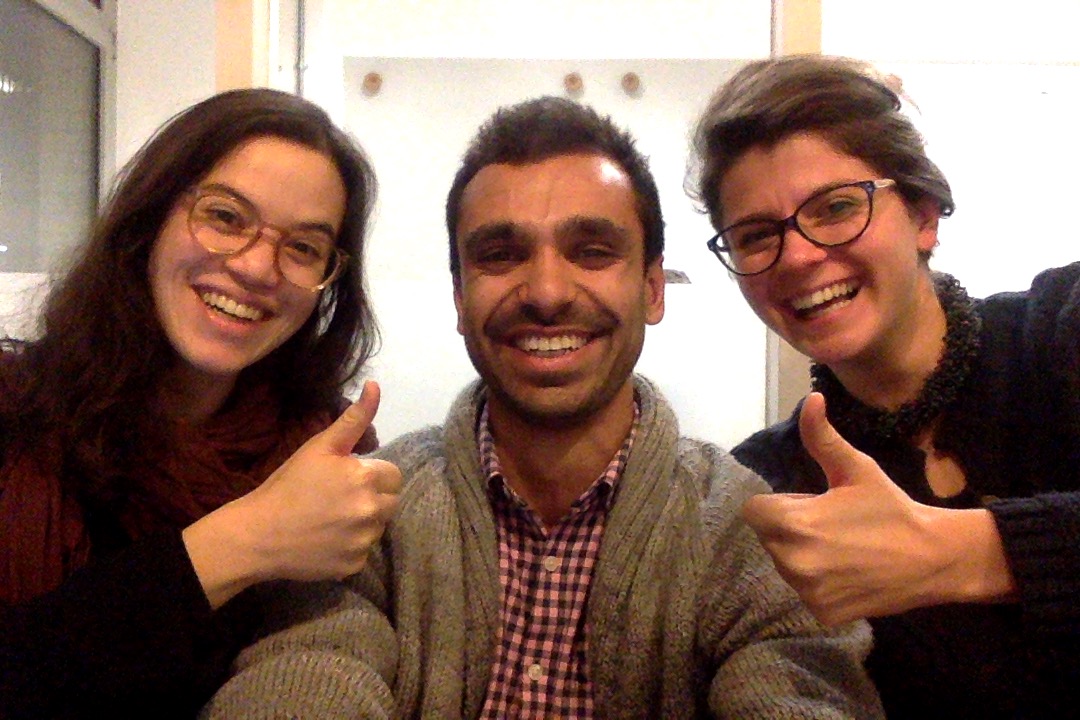
The good problems team: Andrea, Aran and Ana - otherwise known as ‘The A Team’.
With degrees in English and Information Design, Andrea fits right in with our design-led research approach. Her raft of experience ranging from the dramatic (licensing the Canadian security industry) to the downright unexpected (training as a ‘Master Compost Recycler’) means she joined ready to adapt to working in any sector and jumped straight into finding some good problems with us.
She’s already been working on the Flying High project as the designer behind those lovely summary documents we’ve been producing to bring cities up to speed with drone technology. Now she’s taking the lead on the research for the Egypt strand of our Global CoLab project with 100% Open, Nesta and the Newton Fund, and working on redesigning the good problems website — and of course, revamping this blog with a brand new design!
The good problems ‘A Team’ is now bigger and busier than ever, so keep an eye out on this blog and our twitter feed for future updates on our escapades as we take on the world’s problems together…
He came for the job, but he stayed for the snacks: meet the intern who never left.
It’s been almost four months now, so an introduction to the newest member of the Science Practice team is well overdue!
Once upon a time, Aran was a scientist looking after stem cells and exercising his distinctly average pipetting skills on a daily basis. However, much like his new colleague Simon, he decided life in the lab wasn’t for him, and made a dramatic move into science communication instead. In his own words: “talking about science is a lot more fun than actually doing it!”
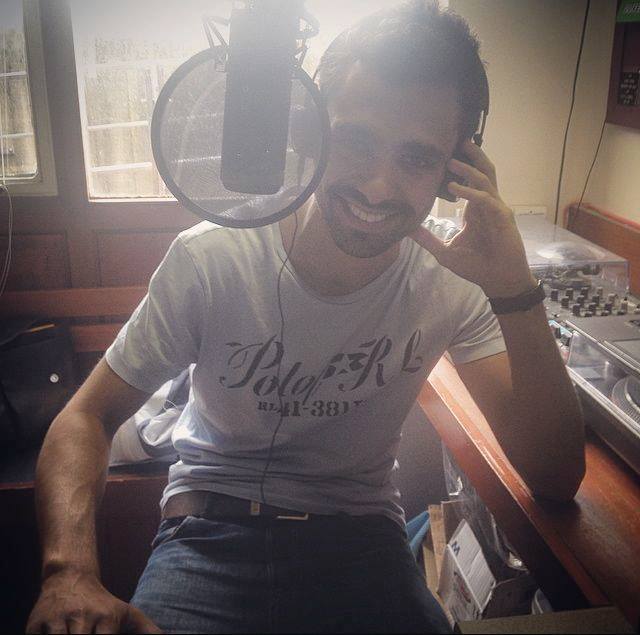
Give a warm welcome to Aran Shaunak - the newest member of the Good Problems team!
After finishing his MSc in Science Communication, he managed to talk his way into Science Practice on a short-term internship with the promise of some free grant money (which is yet to arrive, but we live in hope). A couple of months on, he decided to throw in the towel with big organisations and instead take up a desk as the fifth member of Science Practice.
As Ana’s right-hand-man on the Good Problems team he’s been busy researching drones for the Flying High Challenge and renewable energy in Indonesia for the Global CoLab; designing the first draft of the upcoming Good Problems workshops (stay tuned…) and helping out where he can with Ana’s relentlessly impressive drive to drum up more work. Crucially, he’s also taken over the role of Ana’s Lunch Enforcer, which has been vacant since Tempest sadly left the office.
For the last few months Aran has also been looking after our comms: coming up with a communications strategy to guide us for this quarter, reviving this blog and desperately trying to resist the urge to use #innovation in his tweets. If you drop us a line on Twitter, most likely it’ll be Aran getting back to you!
With his ever-present smile and a desire to get stuck in, Aran has slotted in well here at the office - although he’s still an outsider, as the only member of the team without a Mac.
Welcome to the team, Aran and we’ll make sure to keep that snacks cupboard well stocked!
Visiting Kenya was a landmark event in SoilCards development. It’s the first time that our prototype was in the hands of customers. Luckily it was a hit with the farmers we spoke to, with one even saying “we need these yesterday!”.
A research project started 2 years ago, @soilcards prototypes were in Kenyan farmers hands today. Best feeling in the world! pic.twitter.com/WqnDzNeXVM
— DrTempest van Schaik (@Dr_Tempest) September 22, 2017
SoilCards: soil testing for every farmer
The work of small-scale farmers is vital, producing ~70% of global food supply. But these are some of the poorest people on earth, with over 1 billion living below the poverty line.
SoilCards are the devices that we’re developing to make soil-nutrient analysis easy, quick, and affordable to smallholder farmers who don’t have access to soil-testing laboratories. SoilCards are made entirely of paper, so they’re ultra cheap and portable. They’re inspired by the home pregnancy test, so they’re easy to use and read. They use microfluidic technology which we’ve translated from medicine to agriculture, but so far they’ve been a proof-of-concept device which has been developing in the lab.
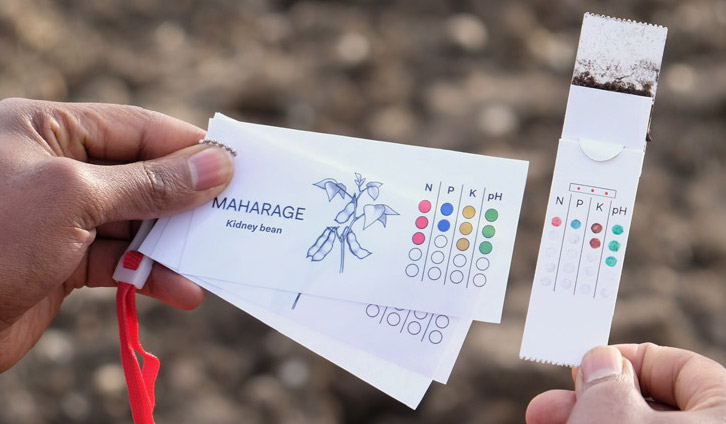
The soil to be tested is added inside the paper SoilCard (right), where it is analysed using microfluidics technology. Spots appear on the display, which represent the levels of the soil nutrients N, P, K, and pH. These test results are compared with a reference card (left) for a specific crop that a farmer wishes to grow. This allows the farmer to see precisely which nutrients to add to the soil.
Why go to Kenya?
Up until this trip, we had been designing and building SoilCards in London, far away from our intended users (smallholder farmers in developing countries). We had tested ideas with UK farmers, but African farming is very different. Thanks to a grant, we were finally able to travel abroad to understand the context that SoilCards will be used in, and get feedback directly from our users. We chose Kenya partly because of existing links between our partners, the UK’s National Institute of Agricultural Botany (NIAB) and the Kenyan Agriculture and Livestock Research Organisztion (KALRO). There are also three important characteristics that helped us choose Kenya:
- Kenya has loads of farmers. About 75% of working Kenyans make their living by farming. Compare that to South Africa where it’s around 10%, and the UK where it’s around 1.5%.
- Kenya is fairly well-off, with the largest GDP in East and Central Africa, and it has had some good agricultural programs. We therefore expected that some farmers would already be aware of the benefits of fertiliser and we could focus on the benefits of soil testing. It would be far more difficult to promote soil nutrient testing in an environment where people are not even familiar with soil nutrients.
- Kenyans are tech savvy. They’re famous for pioneering M-Pesa, which sets a precedent for successful adoption of simple, powerful tech.
Really positive response from our first farmers today! Alex said "We need this yesterday". pic.twitter.com/60SJ8e4l42
— SoilCards (@soilcards) September 22, 2017
What we set out to learn
Having never been to Kenya, we had a long list of questions for our trip, including:
- What is life in Kenya like, what do rural and urban areas look like? We needed to get a basic understanding of the context SoilCards would be introduced into.
- Who are our customers and users? Will SoilCards be used directly by farmers themselves? Our mission is for SoilCards to be a self-sustaining social enterprise (rather than relying on grants), so we need to find out who the key payers are.
- What do stakeholders think of the product and how would they change it? It was critical to get feedback on ergonomics and product design from the users themselves.
- What are general attitudes to soil health and testing? Are farmers open to the concept?
- What channels could we use to get SoilCards to our customers?
Agrovet shops like Pauline’s could be a way to get SoilCards to farmers. She sells fertiliser, seed, pesticide, feed & offers farming advice pic.twitter.com/1CXCcTuGOz
— SoilCards (@soilcards) September 23, 2017
The research team in Kenya
Travelling from the UK was myself from Science Practice leading the project, and Eric Ober from NIAB, who has a wealth of knowledge about UK agriculture and soil health. Our hosts from KALRO in Kenya, whom we spent all 8 consecutive days with, were Joseph Mriti, Esther Muriuki and John Mwangi. Joseph, Esther and John are agricultural scientists based at one of KALRO’s Nairobi offices. Not only are they experts in soil science and farming intervention studies, but crucially they are experts on Kenyan farming in particular.

The team in Kenya, in the Great Rift Valley. From left to right: Tempest, Eric, Joseph, John and Esther.
Who we interviewed in Kenya
In Kenya we spoke to stakeholders from across the spectrum of soil testing:
- 28 smallholder farmers from 3 different regions (Nairobi, Kikuyu, Naivasha)
- 26 government and research institute soil scientists and agricultural researchers
- 5 extension officers from Ministry of Agriculture
- 2 extension officers from private agrochem companies
- 5 owners of agrovets (the stores where agri products are sold)
- 3 startups who pay for soil testing
- 1 fertiliser company
- 1 farm manager of one of the largest farms in Kenya
Today we visited Mea fertiliser manufacturer who test soil & make a custom nutrient blend based on the results, very impressive! pic.twitter.com/cGejiEpL8A
— SoilCards (@soilcards) September 25, 2017
In Kenya, almost all farming is done by smallholders. According to the FAO, the average income in these households is $1.40 per person per day. The smallholder farmers we spoke to ranged in age and income level. While most had small plots of one acre or less and were struggling to make a living, some had larger farms of a few acres and had other people working on their land. Many farmers were self-taught or were taught how to farm by their community, rather than ever receiving any formal training or advice. Most farmers sell their produce at their local market. Their main challenge is low/fluctuating market price for their crops, which makes it hard to cover the cost of farm inputs like fertiliser.
We spoke to Naivasha farmers who’ve never tested their soil. Rely on intuition & collective experience to apply the right fertiliser pic.twitter.com/LVY94ogP6N
— SoilCards (@soilcards) September 27, 2017
Our approach: prototypes and contextual interviews
Prototypes
There was lots of uncertainty around the timing of the trip, which was delayed by the anxiously anticipated 2017 general election in Kenya. However as soon as we got the go-ahead for the trip, we worked tirelessly in the lab at Imperial College with Dr Agnes Chi Leng Leong to make a whole box of prototype SoilCards by hand:
Looking back at all those hours in the lab, getting SoilCards ready for our first trip to Kenya! pic.twitter.com/7hSvtRCvsP
— SoilCards (@soilcards) September 20, 2017
We brought along prototypes that closely mimic how SoilCards will work in future, to demonstrate to different stakeholders. The demo involves placing some soil into the SoilCard and adding water, and after a few minutes spots on the display begin to appear. When the blue bar at the end changes to pink, the test is ready to read. The number of spots is compared to the reference card. After demonstrating it once for them, the stakeholders were given a chance to try it for themselves.
After a pipetting marathon in the lab, we've got a big batch of SoilCards prototypes to test with farmers in Kenya, in just a few weeks! pic.twitter.com/4k7tnlwOVk
— SoilCards (@soilcards) August 30, 2017
Contextual interviews
We insisted on doing farmer interviews on their farms, rather than meeting at say, a school, which is a normal community convening point. This was to give us a chance to observe the surroundings and see exactly what conditions SoilCards will be used in: for example, the brightness of sunlight, availability of shade and shelter or places to store possessions, and quality of roads and transport options (boda boda!). There were two occasions when we asked for water for the demo (water is required to use SoilCards) and it was scooped up in a banana leaf. Without being there in person, there would have been no way of knowing that a banana leaf is the handiest vessel for a farmer to carry water in. For the same reason, we met soil scientists at their laboratories, fertiliser manufacturers at their factory, and shop owners in their stores.
“You only have to try it once, and then you can teach other farmers how to use it.” “It’s empowering to be able to test your soil yourself.” pic.twitter.com/NFu2xZwroc
— SoilCards (@soilcards) September 23, 2017
I was honest about being an engineer who doesn’t know much about farming, and my reason for being there was to learn from farmers. We told farmers that we are building the product for them, so we wanted to hear from them how to make it better. It’s hard to know for sure whether our interviewees were just being polite, but we tried to avoid yes/no questions framed in a positive way, like “Do you like SoilCards” by asking instead “What (if anything) would change life on the farm if you had SoilCards?”.
Going with the flow
We had originally planned to interview farmers one at a time or in small groups. However bigger groups gathered and we didn’t want to turn enthusiastic people away, so we just went along with it. We had spent days writing detailed questionnaires, but in the end, having a chat seemed much more natural. I tried to maintain an open, honest, relaxed and collected composure, even when I stepped into a muddy irrigation channel, disturbed a nest of soldier ants, and had a little girl hugging my calf during a demonstration.
Answers to our questions
The response to SoilCards was overwhelmingly positive. Farmers were intrigued by the devices and were delighted when the spots appeared. They could immediately see the value of knowing nutrient levels before buying fertiliser. After one demonstration they spontaneously started explaining SoilCards to other farmers in the group, and almost every farmer wanted to buy or keep the SoilCards (of course I reiterated that these were just prototypes, not a finished product).
• Attitude to soil health: The farmers we spoke to all understood the importance of soil health and regularly applied fertiliser (organic and mineral), and crop rotation was fairly common practice too. They knew that soil testing was important but said that it was too expensive, and delivering the soil sample required too much effort. To understand soil health, farmers observe how well crops are growing, but this is a costly and lengthy experiment. They tend to apply the same fertiliser that they always have, adjusting it intuitively based on growth. Because SoilCards make soil nutrition visible, farmers instantly recognised that they would take the guesswork out of estimating soil health, and would help them avoid spending money on fertilisers they don’t need.
• Product design & usability: The farmers we spoke to found the spot display easy to understand, and we noted small language modifications like referring to acidity rather than pH. At the end of all the interviews, we had a workshop to decide the easiest way to communicate the actions farmers should take after a test: what fertiliser to buy. We were consistently told that the card should be bigger which was not surprising; engineers in the lab tend to want to make things as small as possible, and farmers hands are larger than ours. One piece of very honest feedback we got was that the dark pink spots looked like drops of blood, an off-putting connotation which we will try to fix.
• Connectivity: Most farmers we spoke to had a mobile phone and access to somebody with a camera phone, but few had smartphones. The M-Pesa payment system is widely used. They were keen to photograph the test result and send it if they could get a detailed interpretation back.
• Distribution: Different stakeholders had different opinions about how best to get SoilCards to farmers. Some farmers favour a free market approach and would prefer to buy SoilCards directly from the agrovet stores where they buy fertiliser. Some agricultural researchers felt that SoilCards would deliver most impact if distributed within a farmer training program. We will probably explore a variety of distribution channels and see which ones have the most impact.
The most popular agrovet in town, each person holds an agronomy degree so they provide expert advice & help interpret soil test results pic.twitter.com/dsIsVfy0FF
— SoilCards (@soilcards) September 23, 2017
Unexpected findings
Discovering new customers: We discovered two new customers on our trip. Both have an interest in increasing farmer productivity and already pay for soil testing:
- Contract farming companies: These are large companies who provide smallholder farmers with seed and farm inputs, and buy the produce from farmers at the end of the season at a pre-negotiated price. These companies obviously have an interest in farmer productivity and they promote soil testing. I actually learned about this because I stepped on one of their branded seed bags while walking around a farm, so these unexpected discoveries are another reason to do contextual research.
- Businesses who provide loans to smallholder farmers: some businesses provide their agricultural products on credit. They have an interest in farmers being able to pay back loans. They pay for soil testing and pass these costs onto farmers, so they would welcome cheaper, faster testing.
SoilCards can facilitate dialogue: We discovered a new use for SoilCards, which is to allow a more meaningful discussion between farmers and anyone who wants to increase farmer productivity. Advice about managing soil nutrients is much more convincing, engaging and persuasive if farmers can see results of their actions. We spoke to one soil scientist and adviser who goes to check up on farmers. She said that she would like to include SoilCards in discussions with farmers because it would make soil testing much more tangible to them. She said that she sets off each day with a backpack for her equipment and lunch, and the best way to get to farms is on a Boda Boda motorcycle taxi. She has to be very selective about what she carries in her bag, but because SoilCards are so small and light she could easily bring them on her visits. We learnt that it is crucial to calibrate the SoilCards display spots to Kenyan lab standards so that the spot display can be interpreted by both farmers and scientists, which facilitates a seamless discussion.
Conclusions
Feedback on our approach
We were told by our hosts that our approach was unusual in that we brought early-stage technology to demonstrate, rather than a finished product, which is the norm. They said that this worked well because it meant that farmers and other stakeholders are involved in the design and development process. This is much more likely to result in a product that farmers will use.
Demonstrating SoilCards to KALRO Kabete staff with range of expertise e.g. irrigation, agrochem, livestock. Great to involve students too! pic.twitter.com/RO7Ib9xZju
— SoilCards (@soilcards) October 3, 2017
What’s next for SoilCards
We are currently looking for funding to continue developing SoilCards. Our trip has demonstrated demand for SoilCards, so we need to go back to the lab to refine our prototype and turn it into a fully functioning product. Ultimately our goal is for SoilCards to be a social enterprise which can sustain itself through sales of an ultra-affordable product. Please get in touch if you know of any funding opportunities!
In the longer term, we see huge potential for farmers to photograph their test result on their phone and get more detailed recommendations back by SMS. This could include information about what specific fertiliser products are currently available at the shops. The discrete spot display will be trivial to count and digitise, whereas colour hue from a traditional chemical test is notoriously difficult to determine using computer vision. Test results could also help build up a detailed map of soil health which could be very useful for government and anyone wanting to monitor and improve farm productivity. Lastly, there is no reason why SoilCards couldn’t work beyond Kenya, and we hope it will make an impact on farmers in other parts of the world too.
Thank yous
We are very grateful to our hosts and research partners at KALRO who did a fantastic job making everything run smoothly. There was an incredible amount of preparation leading up to the trip, and they worked with us for 8 straight days without a break. They were enthusiastic and hospitable and flexible when we wanted to do things differently. We could not have done it without them.
We are also extremely thankful for all the time that each and every stakeholder interviewee gave to us, and for their invaluable, honest feedback.
Unmanned Aerial Vehicles (UAVs) - more commonly known as drones - have rapidly become the go-to gadget for hobbyists and professionals alike. They are regularly used for photography and filming applications, to deliver supplies to remote locations, and even by emergency services in search and rescue operations. But so far, they haven’t been welcome in cities.
The Flying High Challenge, a collaboration between innovation foundation Nesta and Innovate UK, aims to change that. The Good Problems team at Science Practice has been supporting the project by exploring problems that urban drones could solve and the barriers that need to be overcome before drones can be safely and usefully introduced to city skies.
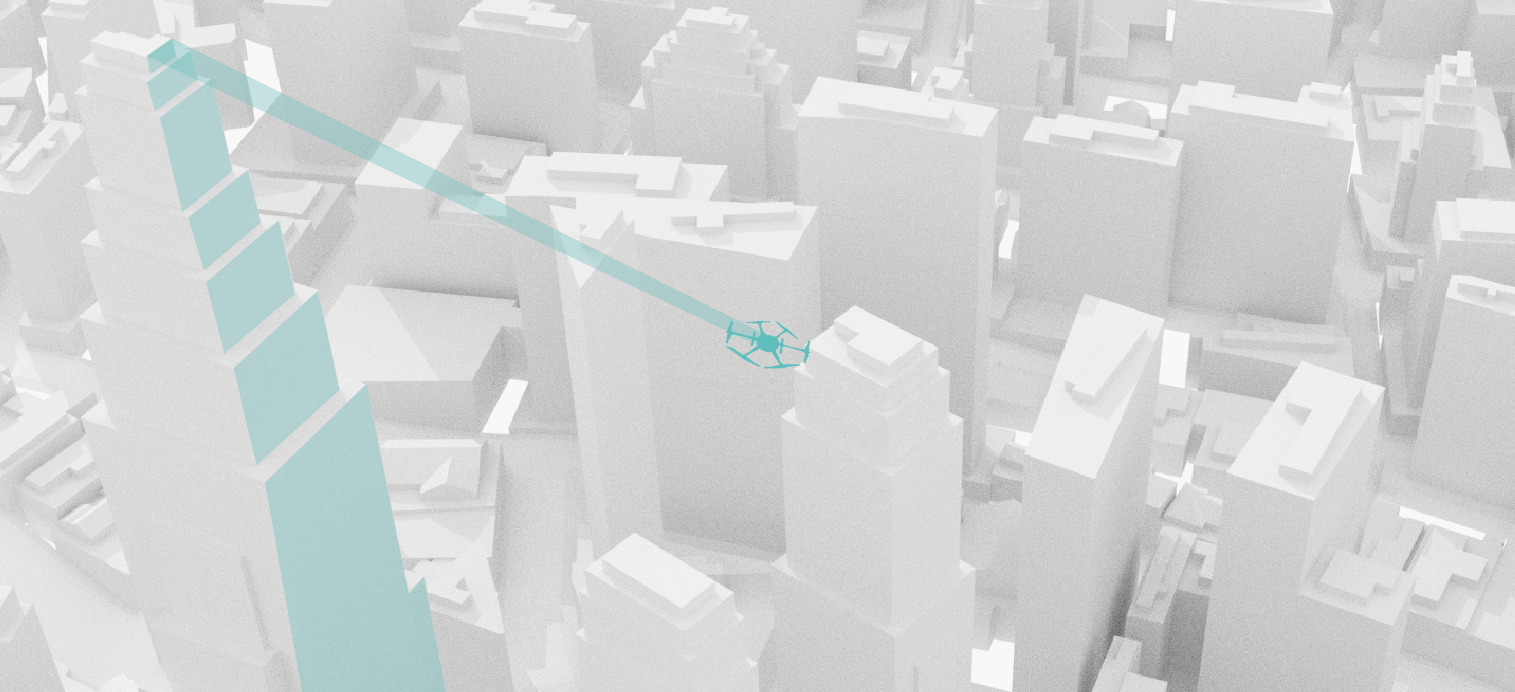
In future, drones could inspect tall buildings, helping workers avoid dangerous work environments.
To solve a problem, first you have to choose a problem. There are a wide range of barriers to introducing drones to cities, ranging from concerns around safety and functionality to restrictions imposed by the law. Through design-led research, we searched for and analysed these barriers to work out which problems the Flying High Challenge should focus on.
First up, there are clear technical difficulties in using drones to perform some tasks. For example, if police or fire departments need to use a drone in an emergency, it’s not very helpful if it can’t fly because of a little wind or rain. Some drones have sensors so advanced they can see through walls, yet they’re being held back by battery technology which limits the hardware they can carry and how long they can fly for. And Amazon wants to bring you your delivery in ten minutes flat? Great. Amazon drops your delivery from 400 feet onto the M25? Less great.
However, we can’t think about these drones in isolation: they’ll need a lot of new infrastructure, and if they’re going to be sharing the same airspace, they’ll have to learn to talk to each other. Cities will need to build recharging stations, maintenance hubs, and loading bays to help drones do their jobs. Drones criss-crossing the skies will need an air traffic control system to plan flight paths and stop them crashing into one another, as well as top-end security to prevent them being hacked or brought down.
There are legal barriers too: current regulations make it almost impossible for councils and businesses to operate drones in urban areas, since they can’t be flown near buildings or crowds (unless they have special permission, like when the London Fire Brigade used a drone to assess the damage following the Grenfell tower fire). In particular, drones can’t be flown autonomously, and have to fly within the visual line of sight of the pilot, which presents real issues for large-scale commercial applications.
How We Helped
To guide the decision-making of city authorities applying to the Flying High Challenge, we first produced an Introductory Pack which summarised our research in an accessible way. Its aim was to help bring cities up to speed with cutting-edge drone technology and help them decide which applications would be most appropriate and useful for their needs.


Urban drone use cases fall into one of five categories: monitoring (shown left), inspecting, delivering goods (shown right), transporting people, or intervening.
There turned out to be a lot of interest: whether they want to use them to deliver organs between hospitals, fight fires, or bring your packages to your door, cities across the UK want to be the first to bring drone technology into the urban environment.
Based on interest areas identified by cities and through our own research, we then shortlisted 13 priority use cases, each of which would offer significant economic and social benefits to citizens if implemented in UK cities. These use cases fall into five categories:
Monitoring environments, individuals and groups: Monitoring air pollution, mapping fires, overseeing construction sites and creating smart road networks.
Inspecting infrastructure and systems: Exploring hazardous environments, inspecting large infrastructure, and maintaining utilities.
Delivering goods: Delivering consumer goods and providing hospitals with medical supplies.
Transporting people: Providing airborne public transport or taxi services.
Supporting existing services: Responding to traffic accidents, managing marine ports, and boosting mobile networks.
We distilled our research on each of these drone applications into digestible one-page summaries. Their aim was to help cities get a clearer picture of which use cases they might be interested in and establish what needs to be done before those applications can become a reality.
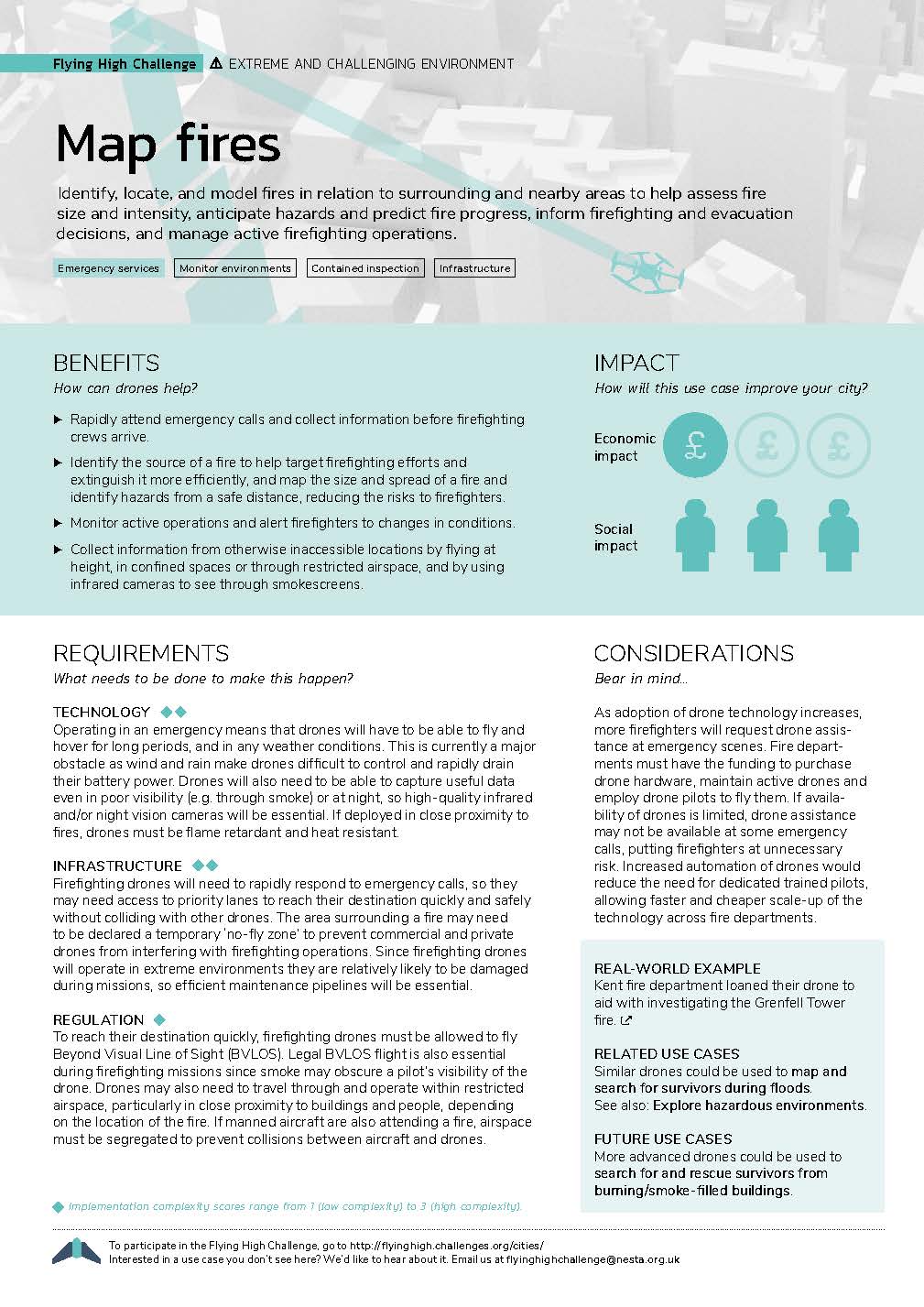
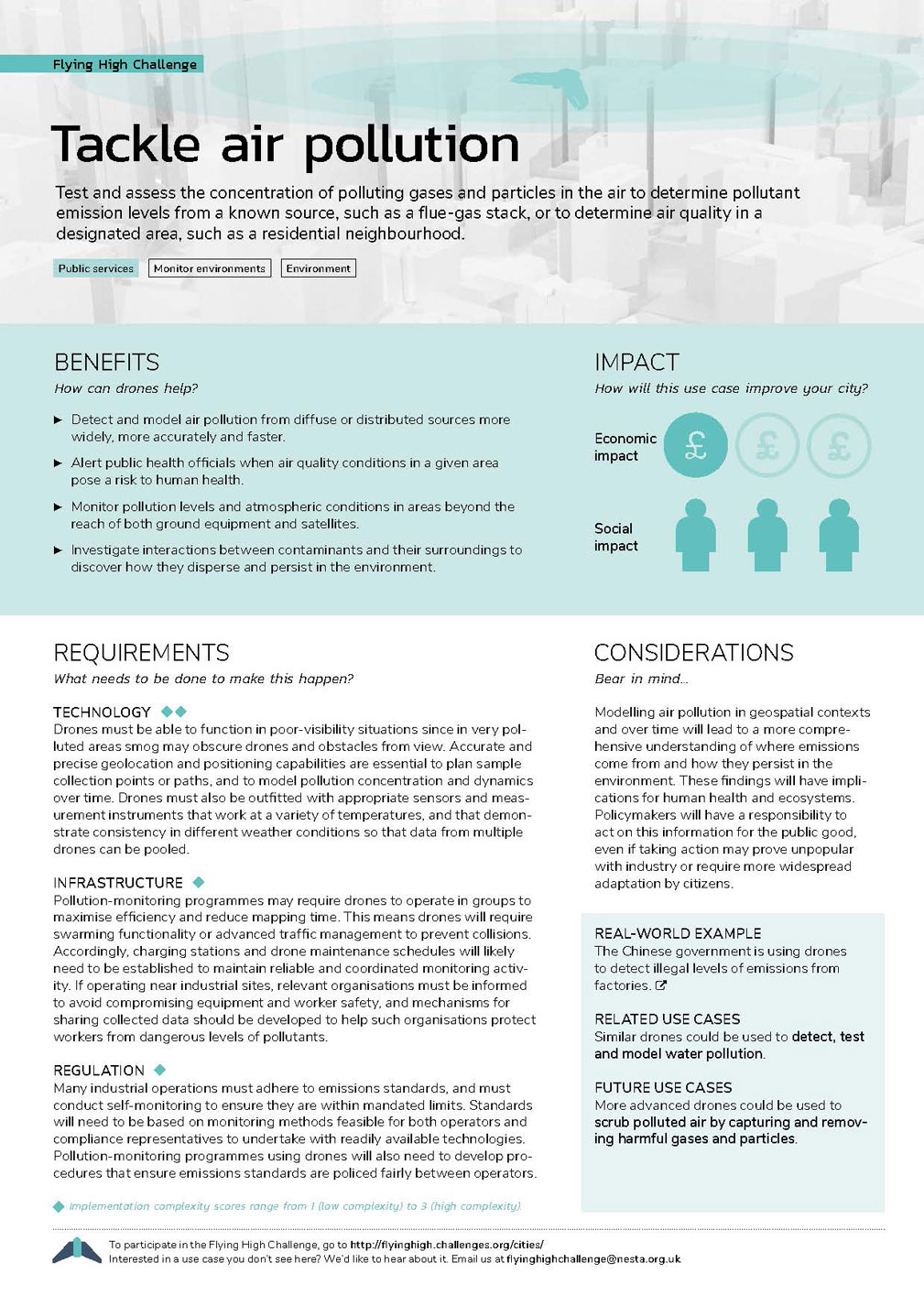
Two examples (left - mapping fires; right - monitoring air pollution) of the one-page summaries we produced for each of the 13 shortlisted use cases. See all use case briefs here.
What’s next?
Last week, the judging panel reviewed applications from cities across the UK and selected five cities to go forwards into the Flying High Challenge. Congratulations to Bradford, London, Preston, Southampton, and the West Midlands! Working together with Nesta, we will now explore each of the finalists’ visions in detail and help them identify specific use cases where drones could add value to their cities.
Join our Good Problems Team to identify science & tech problems and design incentives to solve them
The Good Problems Team at Science Practice works with funders, investors, and philanthropists to design innovative challenges and funding schemes in science and technology. We have designed over 30 challenges and funding calls including the £10M Longitude Prize.
How we work and what we’re working on now
Our approach relies on proposing interesting problems, or ways to encourage communities to solve them – challenge prizes, competitions, funding calls, accelerator programmes. We do this by creating design proposals which we then test in interviews with diverse stakeholders. This allows us to have focused conversations and helps us build a better understanding of problems, solvers and challenges.
We have designed challenges and funding calls covering problems like antimicrobial resistance or water desalination for the Longitude Prize, sanitation in humanitarian settings for the Humanitarian Innovation Fund, and non-animal protein sources and opportunities for re-engineering soil for the Frontier Prize.
We are currently working on a project exploring the commercial potential of unmanned aerial vehicles (UAVs) in urban settings. We’re also looking to publish some of our methodologies and tools.
We’re looking for someone who:
- Has excellent design skills and a background in one or more design disciplines such as interaction design, product design or communication design.
- Has excellent research skills and enjoys exploring new scientific and technical domains through desk research and by interviewing experts.
- Is literate in science and technology and capable of identifying opportunities and barriers to innovation.
- Writes well and enjoys expressing complex subject matter in simple, engaging language.
- Can present ideas and concepts visually.
- Is excited about collaborating with domain experts such as scientists and engineers.
What we’re offering
As well as a competitive salary we are offering matched pension contributions and family-friendly and flexible working arrangements.
Science Practice is an equal opportunity employer and we value diversity and inclusion at our company. We welcome people of different nationalities, backgrounds, experiences, abilities and perspectives.
How to apply
Please send an email with your CV and/or portfolio and a brief cover letter to Ana at af@science-practice.com. Thanks and look forward to hearing from you!
No agencies please

